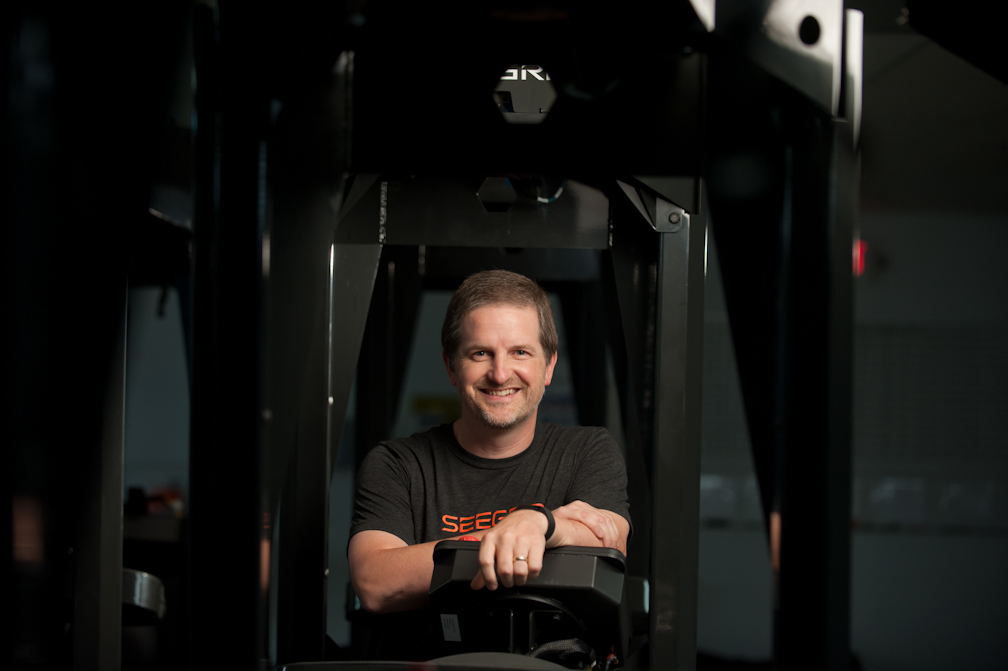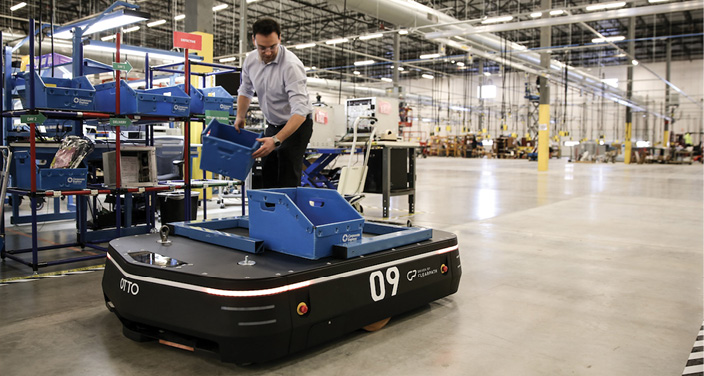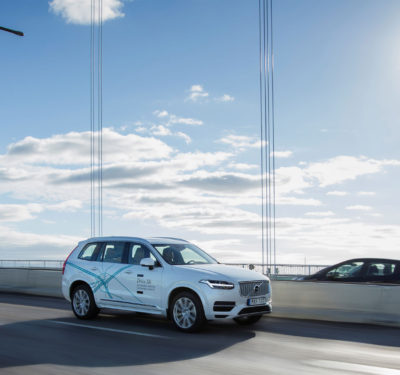
The team at the GE Healthcare Milwaukee repair facility is always looking for ways to improve efficiencies and to automate more processes—and that includes moving materials through the 280,000 square foot building.
The lean manufacturing facility serves as the repair operations center for all GE Healthcare equipment, which means materials are constantly traveling to and from the 250 “repair cells” it houses, said Patricio Espinosa, director of Americas repair operations at GE Healthcare. The production lines start and finish repairs at different times, making it difficult to program a vehicle to simply go from one end of the facility to the other picking up and dropping off materials. To truly automate materials delivery, GE needed a solution employees could beckon at a moment’s notice—one that could navigate from point A to point B on its own.
After researching seven different options, Espinosa and his team settled on the OTTO self-driving industrial vehicle from Clearpath Robotics. Its biggest benefit? The ability to reroute when necessary.
“The OTTO can look all the way around it and understand where it is based on the layout of the facility,” Espinosa said. “If something is blocking it, it can turn around and take another route. It knows the facility. That gives us a lot more flexibility and efficiency on the floor.”
Facilities like this one have focused on automating their processes for years, but weren’t able to apply that to materials movement until recently, said Jeff Christensen, vice president of products and services for Seegrid, a company that develops vision-guided vehicles for industrial settings.

Jeff Christensen
How They Work
Some of the earlier driverless indoor vehicles relied on wires in the floor, magnets or tape to guide them along the correct path, Christensen said, with the next generation turning to LiDAR units. Others act more like a metro bus system, making timed stops throughout the day. The Seegrid vision-guided vehicles use stereo cameras, which have two or more lenses, with a separate image sensor or film frame for each lens, to successfully complete material transport. The vehicle has five pairs of cameras that take pictures of the environment as it travels and and then creates a data dense, 3-D point cloud.
“We can identify any given point in the facility, and then as the vehicle navigates through, we compare the pictures that we take,” Christensen said, noting these vehicles might move a pallet of goods that needs to be shelved in the warehouse or deliver parts to an assembly line. “Because we take the pictures in stereo we can get them in 3-D space. Monocular cameras don’t give you the depth of field to really have an accurate depth measurement, but with the stereo cameras, you can compare two images and get accurate depth representation of all points. You get a good 3-D point cloud using nothing but cameras.”
The technology Clearpath Robotics uses is very similar to what manufacturers tend to turn to for outdoor self-driving cars, CEO Matt Rendall said, with many of them incorporating LiDAR, radar and GPS inertial systems. All sensory inputs inside the OTTO are combined into a self-driving control system. The difference? The indoor environment is more controlled, so the OTTO only uses a 2-D laser scanner and relies on its software and sensor capabilities instead of GPS to navigate.

“Ultimately the self-driving control system takes inputs from all different sensors, interprets the inputs and then makes decisions on the next action,” Rendall said. “With a Google car it’s taking a passenger from one place to the next, in a factory it’s taking a pallet from the pick up to the drop off location. It’s very similar.”
When an OTTO arrives in a factory, it takes a tour of the facility just like a new forklift driver would, Rendall said. As OTTO gets oriented, it uses the sensors on board to create a base map that will enable it to operate autonomously—a process that’s also key for a driverless passenger car. But unlike a driverless passenger car, OTTO doesn’t have the benefit of years of GIS and traffic data or road network data that provides road names and speed limits—that is something the team must create. Working closely with their customers, they develop road networks in these facilities and establish addresses for the areas the OTTO fleet will need to travel to and from.
Once addresses for shelving and assembly lines are configured, the system is connected to a network of smartphones on the factory floor, Rendall said. Operators press a button on a smartphone or tablet when they need a vehicle, the OTTO arrives within minutes and operators then press another button to tell it where to go. The system automatically matches the job to the right vehicle for the most efficient workflow.
The Benefits
Deploying industrial vehicles inside factories and warehouses smooths operations and makes material movement more predictable and reliable, Christensen said.
“You don’t have people who don’t show up for work one day or who stop in the middle of the aisle to talk to a buddy about last night’s game or who stop to take a smoke break,” Christensen said. “Humans introduce unpredictability and that generates cost. Automation has a direct economic benefit and a very significant safety benefit as well.”
As with driverless passenger cars, driverless industrial vehicles can potentially reduce the number of accidents caused by human error, Rendall said. In fact, many of Clearpath’s customers are motivated to purchase an OTTO because they want to improve safety in their operations. Fortunately indoor systems, including the more automated systems, do not have to deal with the same sort of regulatory barriers and infrastructure issues facing driverless passenger cars, enabling companies to implement them more quickly.

Matt Rendall
“The promise of self-driving vehicles solves sizeable problems combining the benefits of cost, repeatability and predictability of automated systems with flexibility and a low barrier to entry,” Rendall said. “If you look at traditional automation systems, most behave like a metro system. Just like everyone experiences when riding the subway and you have to wait for 18 stops to get where you’re going, there’s no value added. If the train system goes down your entire line goes down and you lose production. Self-driving vehicles let us move from trains to an autonomous taxi cab or Uber inside the factory. If we accomplish that, we change the economics of the manufacturing process.”
The Challenges
Manufacturing facilities tend to embrace automation, Christensen said, but automating material handling is a newer concept for this sector. He recently visited a German automobile plant with spot welding arms as far as the eye could see. But when he turned just 20 degrees to the left, he saw 30 or 40 people driving manual tuggers to deliver parts to the automated lines. The managers of this facility, like at many others, understood the value of automation but, at least to that point, hadn’t found a way to automate materials transport.
Part of the reason is that, while self-driving vehicles had been available, they required some type of infrastructure-based navigation system to work—and that meant building a custom system and carving up the floor to install wires, Christensen said, an approach that could hinder operations.
“U.S. based manufacturing is a challenging environment,” Christensen said. “You have to be nimble and able to control costs and add value when you can. To do that you have to be flexible in what you can change. They want to automate but they need to be able to do that without painting themselves into a corner.”
One of the challenges Clearpath Robotics often comes across is getting their self-driving cars to piggy back on a facility’s existing network infrastructure, Rendall said. Every warehouse and building is different. A transport fleet, whether it comprisies as few as two vehicles or more than a dozen, must also integrate with each client’s Enterprise Resource Planning (ERP) software. And then, of course, the team must make sure everything is secure—which is vital to clients like GE.
“Being a larger business we need to have a lot of security around firewalls and make sure we’re not just connected but that we also have the proper security measurements,” Espinosa said. “That took about four months to get installed and we’ve been using the OTTO for three months. The first month was a soft start where we only used it certain hours a day to get the process going and employees used to having the self-guided vehicles in the facility.”
Insights for Driverless Cars
Car manufacturers working to develop driverless passenger cars might learn a thing or two from the technology enabling self-driving industrial vehicles. In fact, Rendall believes the indoor autonomous transport sector will lead the way for self-driving outdoor vehicles.
“A busy factory is like a small indoor city,” Rendall said. “We have control over infrastructure and intersections and security, so it’s an ideal proving ground for concepts that can later roll out to outdoor cities.”
When talking about autonomous passenger cars, the conversation usually centers on vehicle-to-vehicle and vehicle-to-infrastructure communication, Rendall said, and how to make those communications effective and secure. Companies like Clearpath Robotics are already dealing with, and learning from, those challenges indoors. For example, he sees an opportunity for intersections to be managed much differently than they are today. If autonomous vehicles communicate with other vehicles and infrastructure, why is there a need for traffic lights?
“We’re encountering those problems in factories today. That’s very exciting,” Rendall said. “I think outdoor self-driving vehicles will get there, but it will take decades before we have enough driverless vehicles on the road to enable that type of change.”
Well-established safety guidelines and regulations represent another advantage indoor self-driving vehicles have over driverless passenger cars, Christensen said. Manufacturing facilities and warehouses have worked within these safety constraints for years and understand the redundant safety systems and risk assessment required for autonomous travel. While the U.S. Department of Transportation is working on setting guidance and regulations for self-driving passenger cars, Christensen sees this as a challenge.
Most car manufacturers continue to research a variety of sensors, looking for the right mix that will provide these vehicles with all the environmental information they need to maneuver safely on their own, Christensen said. While this approach makes sense, technology will continue to evolve, and as it does, he sees one sensor emerging as a standalone option, much like the stereo cameras used in Seegrid’s vision-guided vehicles.
“If you require multiple sensors to get a thorough understanding of the environment, that introduces a tricky variable from an engineering and regulatory standpoint,” Christensen said. “If I have LiDAR and a camera unit and combine them to give me a view of the world, how I combine them creates a variable I need to test independently to have a safety rated system. That’s one of the things we can teach. With our stereo cameras we have a sensor that can give you very dense data and 3-D range data to an accurate and precise level. You get both image data and 3-D depth data from a single sensor, which has value from an engineering complexity standpoint, safety and esthetics.”
The Future
Technology for outdoor and indoor autonomous vehicles will continue to evolve, and companies like GE that are known for embracing innovation and automation, want to see even more capabilities in these systems. For Espinosa, who has two OTTOs for now, that means finding a better way to hand off the material once the OTTO arrives at the production line or in the shipping area. Right now a person is tasked with that job, but he’d like to see an automated mechanism, maybe a conveyor belt, handle that as well, but that means developing something that can transfer materials that come in a variety of shapes and sizes.
The idea of using automation inside these facilities isn’t new, Rendall said, and industry members are excited to see where this latest technology might lead.
“Our vision is that the world becomes driverless, it’s just a matter of how quickly,” he said. “In the world of factory logistics there’s this Holy Grail vision of lights out, or a world where the entire operation is automated end to end and you’re able to turn off the lights because machines don’t need the lights on. That’s the vision for manufacturing. I can’t tell you how many facilities I’ve been to where they have a $100 million automation cell in one location or a $200 million cell in another area but they have somebody pushing a cart feeding materials into those machines or taking materials out. With self-driving vehicles you can finally connect those islands and achieve truly lights out automation.”






